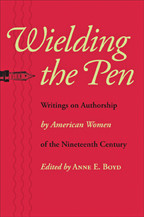Wielding the Pen presents a wide spectrum of nineteenth-century American women’s writings on the themes of authorship and creativity. These works reflect the fears, desires, and motivations of female authors, as well as the opportunities and obstacles they encountered as professional writers.
Anne E. Boyd includes representative samples from a diverse range of writers. These writings, some of which are reprinted here for the first time, challenge prevailing notions about women and authorship in the nineteenth century and shed light on the relationship between women’s lives as writers and their...
Wielding the Pen presents a wide spectrum of nineteenth-century American women’s writings on the themes of authorship and creativity. These works reflect the fears, desires, and motivations of female authors, as well as the opportunities and obstacles they encountered as professional writers.
Anne E. Boyd includes representative samples from a diverse range of writers. These writings, some of which are reprinted here for the first time, challenge prevailing notions about women and authorship in the nineteenth century and shed light on the relationship between women’s lives as writers and their evolving roles in the larger, male-dominated literary community.
Boyd uses these essays, letters, poetry, fiction, and reviews to examine varied experiences of authorship. Here are the voices of women writers speaking about the hardships and rewards of authorship, responding to male critics, and encouraging and warning young, aspiring writers who would join them in the ranks of professional writing.
Boyd’s introduction places the views of female writers on authorship into historical perspective, and brief biographical and critical sketches of each author and their work are also included. The texts are presented chronologically and are indexed by author, genre, theme, and region.
This anthology of primary materials—the words of American women writers on the act of authorship and their participation in the literary cultures of the nineteenth century— offers revealing insight into Hawthorne’s "damned mob of scribbling women."







